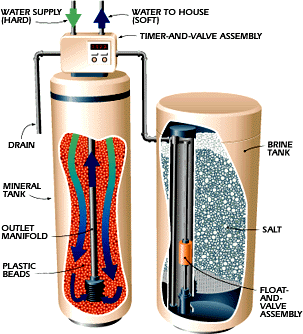Dissolved calcium and magnesium precipitate out of hard water as scale, which builds up on the insides of pipes, water heaters, kettles, coffee makers and industrial machinery. Scale reduces flow through pipes and is a poor conductor of heat. Eventually, pipes can become completely clogged.
Hard water reduces soap’s ability to lather, whether in the shower, sink, dishwasher or washing machine, and reacts with soap to form a sticky scum.
Water softeners remain the least costly and most effective way to rid your water of troublesome minerals.
Water softeners operate on a simple principle: Calcium and magnesium ions in the water switch places with more desirable ions, usually sodium. The exchange eliminates both of the problems of hard water because sodium doesn’t precipitate out in pipes or react badly with soap.
Water softeners come in many different sizes. A water softener takes about 1 hour to do a complete backwash cycle. The backwash cycle is normally programmed for 2 am in the morning.
Salt (NACL) is used in the backwash cycle to backwash and exchange minerals for Sodium.
The salt is kept in a brine tank which the water softener will draw out of the brine tank for the regeneration process.
To correctly size a water softener you will need the hardness level of the water measured in PPM and the amount of water you need in 24 hours.
Commercial & Industrial
Water Softeners
Dissolved calcium and magnesium precipitate out of hard water as scale, which builds up on the insides of pipes, water heaters, kettles, coffee makers and industrial machinery. Scale reduces flow through pipes and is a poor conductor of heat. Eventually, pipes can become completely clogged.
Hard water reduces soap’s ability to lather, whether in the shower, sink, dishwasher or washing machine, and reacts with soap to form a sticky scum.






Reviews
There are no reviews yet.